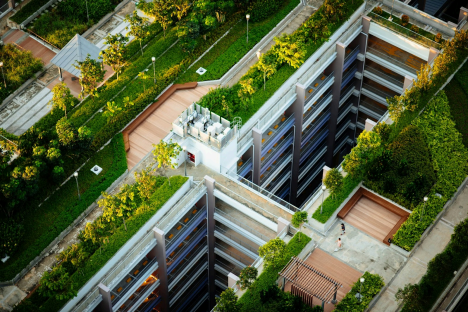Planting small trees on roofs of buildings in dense urban areas can reduce flood volume and runoff

In the past decade, floods in big and densely populated cities have become more frequent. They are increasingly causing damage to property and infrastructure, and loss of life. As buildings, pavements and roads made of concrete or tar increase, water-absorbent areas on the ground reduce. After heavy rainfall, water flows rapidly in large volumes and quickly accumulates in low-lying areas. Risks of epidemic breakout and infections after the floods recede are higher due to the dense population over a large area. Any damage to centres of commercial and national importance situated in cities can also potentially affect a larger population.
Floods in cities are very different from rural floods in their nature, causes and effects. They need different analysis and mitigation methods. Cleaning stormwater drains, adding stormwater silos that can act as local storage and avoid runoff, interlinking lakes and installing water pumps to remove accumulated water are some measures that the administration is implementing centrally. However, these methods involve large infrastructure changes and are expensive. Implementing
small-scale distributed measures such as rainwater harvesting, rain gardens and green roofs that help control runoffs closer to their source is more sustainable.
Small-scale and sustainable measures cost less than large infrastructure changes. However, it is important to study their effectiveness and quantify their benefits. In one such effort, Tushar Bose, faculty, CEPT University, Ahmedabad and Prof Pradip Kalbar and Prof Arpita Mondal at the Indian Institute of Technology Bombay (IIT Bombay) evaluated the performance of ‘green roofs’ in reducing floods in dense urban areas. The study was published in the Journal of Environmental Management. The project received funding from the Science and Education Research Board, Govt. of India.
Green roofs are created by planting trees on rooftops of buildings in a shallow layer of soil over a waterproof membrane and a drainage system. Green roofs can keep the building cooler in summer and absorb rainwater. Excess water can help slowly recharge the rainwater harvesting system, avoiding fast runoff. Installing green roofs needs additional expenditure and increases the weight load on the building. It also needs regular maintenance. So, the advantages of implementing green roofs must be carefully evaluated against their cost.
Previous studies assessing the effectiveness of combined strategies such as rain gardens, infiltration trenches and green roofs are available for Western countries. There are very few studies that assess the performance of only green roofs, especially in the Indian context. In India, not all buildings are suitable for green roof installation. For example, slums and some low-cost housing have roofs of metal or concrete sheets and thus are not suitable for green roof installation. “A significant contribution of the study is that it provides a realistic performance assessment in a highly dense urban area and quantifies the overestimation of runoff reduction. These overestimates arise from scenarios that consider all rooftops without evaluating the green roofing potential,” say the authors.
The researchers chose the Odhav area of Ahmedabad, Gujarat to study the effectiveness and performance of green roofs. They divided the total area of 100 hectares into nineteen sub-catchments to create the model. They identified buildings suitable for green roof installation. Buildings with roofs of metal or concrete sheets and industrial buildings are not considered suitable. They considered land use, local rainfall patterns, the terrain and natural pathways of the water drainage of each area to calculate the runoff and flood volume in the sub-catchments. They created a computer model that mimicked how water flowed in the area. Using this model, they calculated the runoff and flood volume assuming different scenarios of heavy rainfall events and various percentage values of green roof implementation.
The data that the researchers used included the model of the terrain of the area, soil type, stormwater network layout, and whether the land is unused or used for buildings, gardens or other purposes, obtained from the Ahmedabad Municipal Corporation and in-person surveys; and rainfall data from IMD.
The IIT Bombay team considered scenarios where green roofs were installed in 25%, 50% and 75% of the suitable buildings. They calculated the flood volume reduction for a total of 36 scenarios, where they considered three green roof application rates (25%, 50% and 75%), four extreme rainfall event frequencies (extreme rainfall events once in 2, 5, 10 and 25 years), and three scenarios of extreme rainfall event duration (2, 3 and 4 hours). They also explored the minimum application rate needed for each of the 12 scenarios created by varying the extreme event frequency and duration. The researchers also calculated the uncertainties in the model predictions.
The study finds that using green roofs can reduce the flood volume by about 10-60% depending on the percentage of green roof application for higher than usual rainfall of one in two year frequency. However, the reduction is not linearly proportional to the application rate because flood volume also depends on the drainage network capacity, especially at high volumes of rainfall. The researchers observed that when less than 25% of buildings have green roofs, the flood volume and runoff reductions can be as low as 5%. When the green roofing is more, there is a collective effect over the whole area and flood volume is reduced. The study also quantifies the uncertainty in the prediction of flood volume reduction and finds that the rainfall intensity contributes maximum to the uncertainty of runoff reduction.
The findings of the study can help policymakers make informed decisions about city-specific green roof implementation.
| Article written by: | Arati Halbe |
| Image/ Graphic Credit | Photo by CHUTTERSNAP on Unsplash |
| Link to Gubbi Labs |
